warning CHEVROLET BLAZER 1998 2.G Owners Manual
[x] Cancel search | Manufacturer: CHEVROLET, Model Year: 1998, Model line: BLAZER, Model: CHEVROLET BLAZER 1998 2.GPages: 416, PDF Size: 22.4 MB
Page 13 of 416
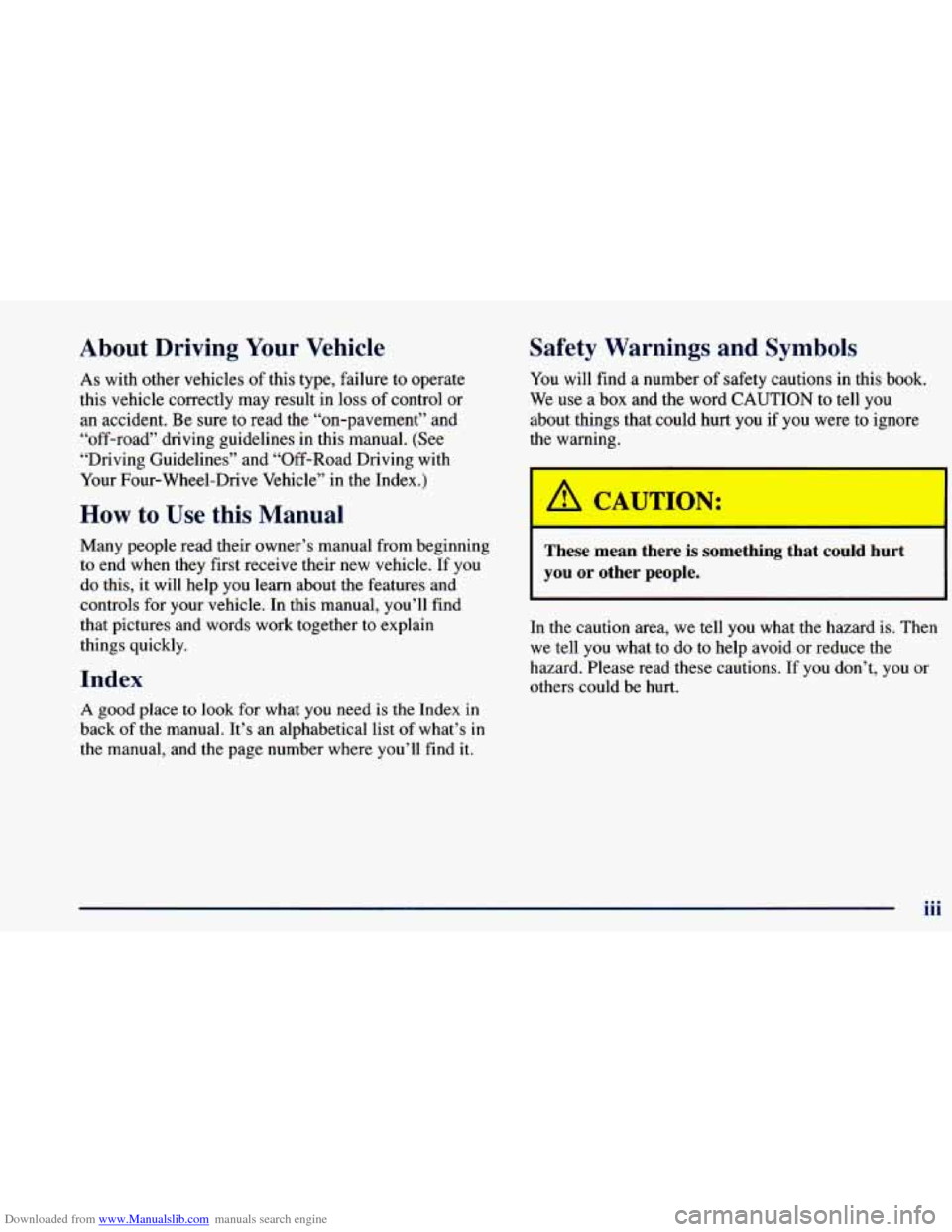
Downloaded from www.Manualslib.com manuals search engine About Driving Your Vehicle
As with other vehicles of this type, failure to operate
this vehicle correctly may result in loss of control or
an accident. Be sure to read the “on-pavement” and
“off-road” driving guidelines in this manual. (See
“Driving Guidelines” and “Off-Road Driving with
Your Four-Wheel-Drive Vehicle” in the Index.)
How to Use this Manual
Many people read their owner’s manual from beginning
to end when they first receive their
new vehicle. If you
do this, it will help you learn about the features and
controls for your vehicle. In this manual, you’ll find
that pictures and words work together to explain
things quickly.
Index
A good place to look for what you need is the Index in
back of the manual. It’s an alphabetical list of what’s
in
the manual, and the page number where you’ll find it.
Safety Warnings and Symbols
You will find a number of safety cautions in this book.
We use a box and the word CAUTION to tell you
about things that could hurt you if you were to ignore
the warning.
The! !an there is something that could hurt
you or other people.
In the caution area, we tell you what the hazard is. Then
we tell you what to do to help avoid or reduce the
hazard. Please read these cautions. If you don’t, you or
others could be hurt.
iii
Page 14 of 416
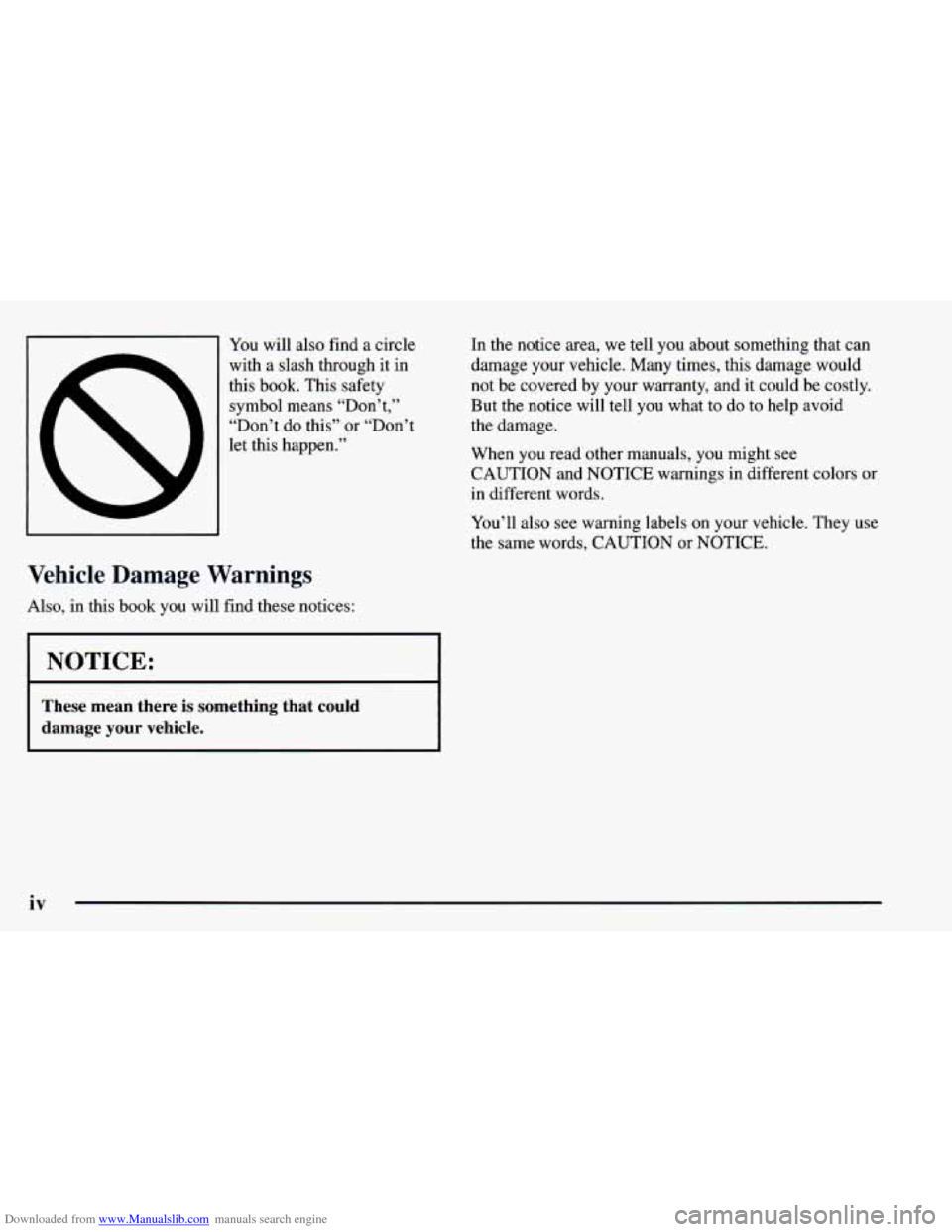
Downloaded from www.Manualslib.com manuals search engine You will also find a circle
with a slash through it in
this book. This safety
symbol means “Don’t,’’
“Don’t do this” or “Don’t
let this happen.”
Vehicle Damage Warnings
Also, in this book you will find these notices:
I NOTICE:
These mean there is something that could
damage your vehicle.
In the notice area, we tell you about something that can
damage your vehicle. Many times, this damage would
not be covered by your warranty, and it could be costly.
But the notice will tell you what to do to help avoid
the damage.
When you read other manuals, you might see CAUTION and NOTICE warnings in different colors or
in different words.
You’ll also see warning labels
on your vehicle. They use
the same words, CAUTION or NOTICE.
iv
Page 15 of 416
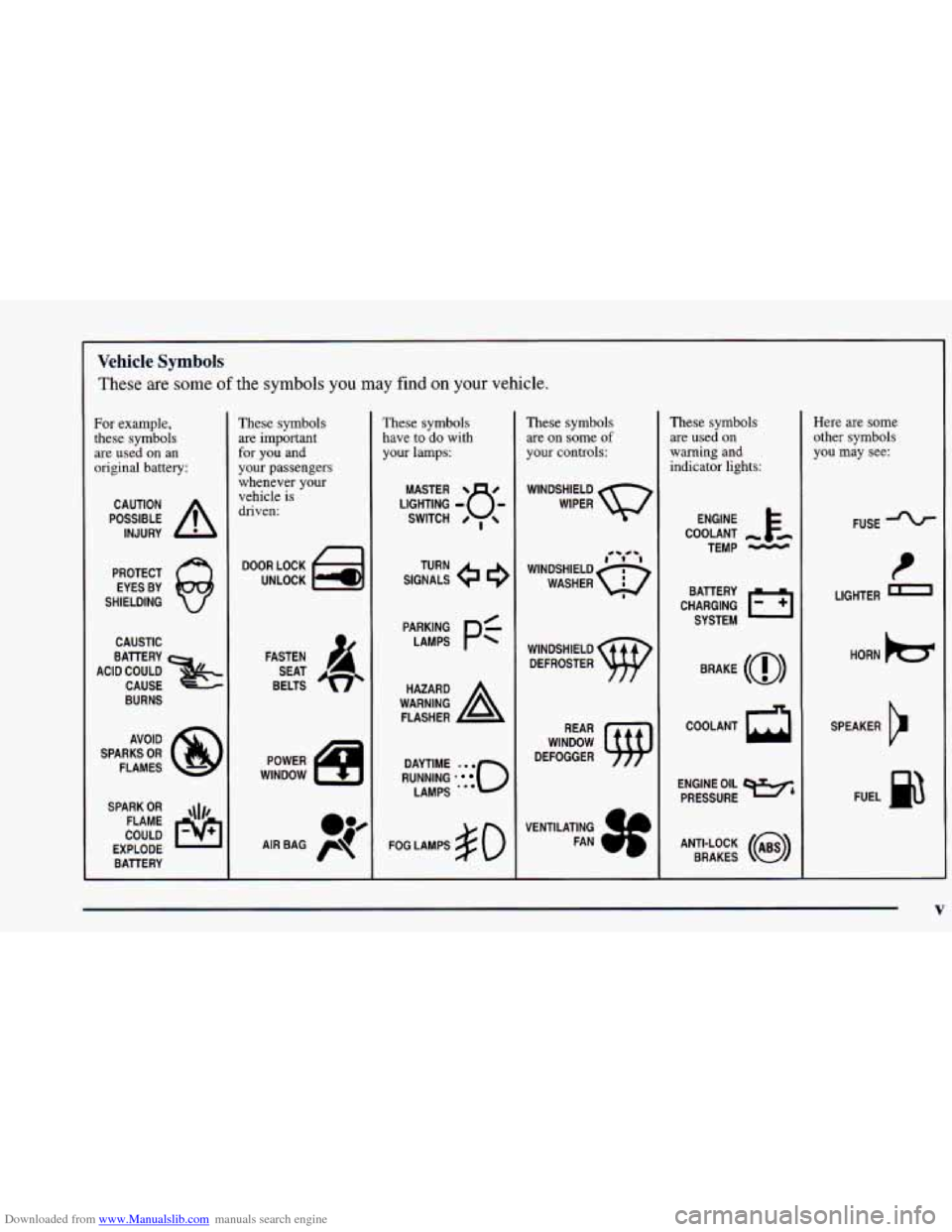
Downloaded from www.Manualslib.com manuals search engine Vehicle Symbols
These are some of the symbols you may find on your vehicle.
For example,
these symbols
are used on an
original battery:
POSSIBLE A
CAUTION
INJURY
PROTECT EYES BY
SHIELDING
CAUSTIC
BURNS
SPARK
OR ,111,
COULD FLAME
EXPLODE BATTERY
These symbols
are important
for you and
your passengers
whenever your vehicle is
driven:
FASTEN
SEAT
BELTS
POWER
WINDOW
These symbols have
to do with
your lamps:
SIGNALS e
TURN
RUNNING
* 0
DAYTIME . . .
LAMPS "'
FOG LAMPS # 0
These symbols
are on some
of
your controls:
WINDSHIELD
DEFROSTER
WINDOW
DEFOGGER
VENTILATING FAN
These symbols
are used on
warning and
indicator lights:
COOLANT -
TEMP -
BRAKE (a)
h COOLANT
ENGINE OIL
e,
PRESSURE
ANTI-LOCK
(@)
BRAKES
Here are some
other symbols
you may see:
FUSE -%-
I
LIGHTER m
HORN b
SPEAKER
b
FUEL 93
J
V
Page 75 of 416
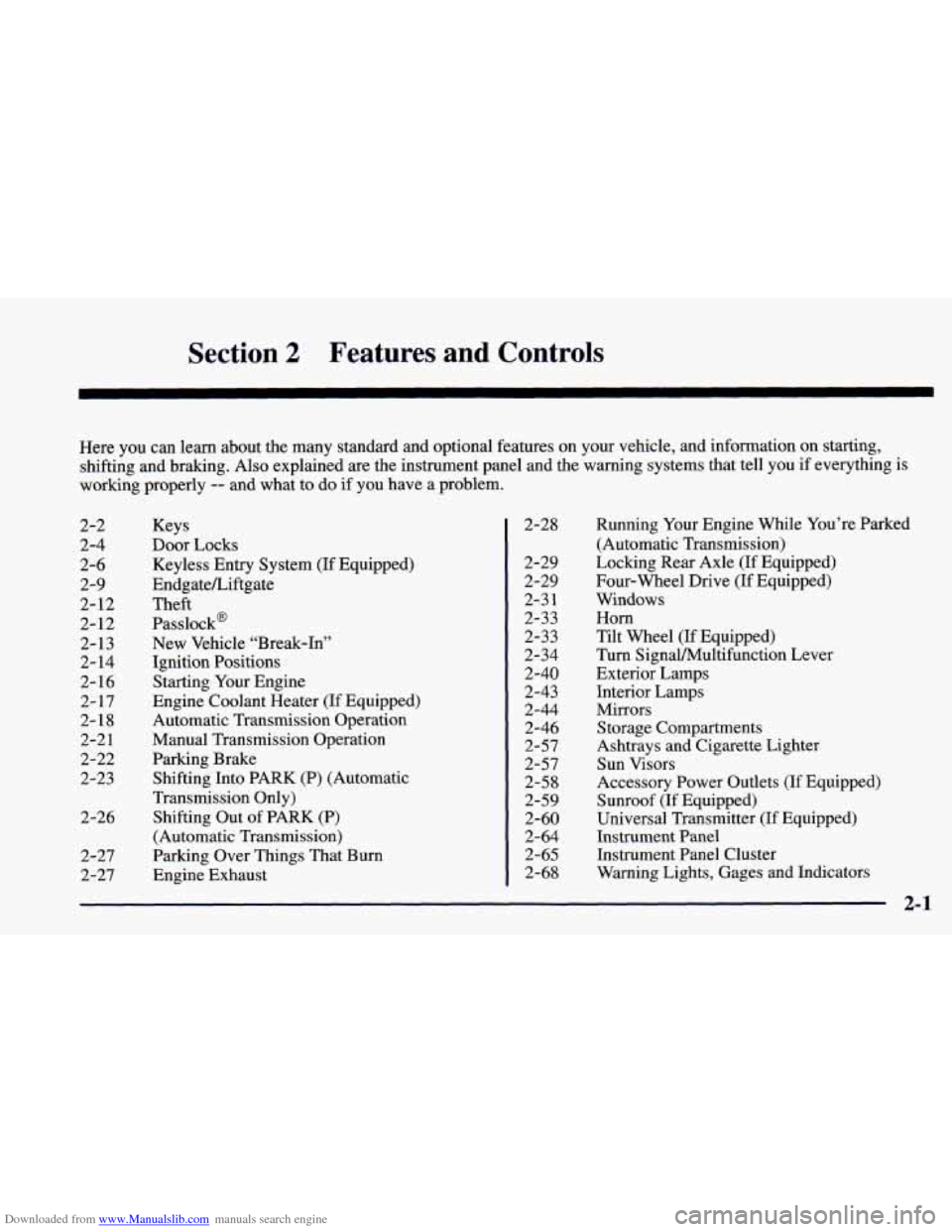
Downloaded from www.Manualslib.com manuals search engine Section 2 Features and Controls
Here you can learn about the many standard and optional features on your vehicle, and information on starting,
shifting and braking. Also explained are the instrument panel and the warning systems that tell you if everything is
working properly
-- and what to do if you have a problem.
2-2
2-4 2-6
2-9
2-
12
2- 12
2-13
2- 14
2- 16
2-17
2-
18
2-2 1
2-22
2-23
2-26 2-27
2-27 Keys
Door Locks
Keyless Entry System (If Equipped)
EndgateLiftgate
Theft
Passlock@ New Vehicle “Break-In”
Ignition Positions
Starting Your Engine
Engine Coolant Heater (If Equipped)
Automatic Transmission Operation
Manual Transmission Operation
Parking Brake Shifting Into PARK (P) (Automatic
Transmission Only)
Shifting Out
of PARK (P)
(Automatic Transmission)
Parking Over Things That Burn
Engine Exhaust 2-28
2-29
2-29
2-3
1
2-33
2-33
2-34 2-40
2-43
2-44
2-46
2-57
2-57
2-58 2-59
2-60
2-64
2-65
2-68
Running Your Engine While You’re Parked
(Automatic Transmission)
Locking Rear Axle
(If Equipped)
Four-wheel Drive (If Equipped)
Windows
Horn
Tilt Wheel (If Equipped)
Turn SignaVMultifunction Lever
Exterior Lamps
Interior Lamps
Mirrors Storage Compartments
Ashtrays and Cigarette Lighter
Sun Visors
Accessory Power Outlets
(If Equipped)
Sunroof
(If Equipped)
Universal Transmitter
(If Equipped)
Instrument Panel
Instrument Panel Cluster
Warning Lights, Gages and Indicators
2-1
Page 96 of 416
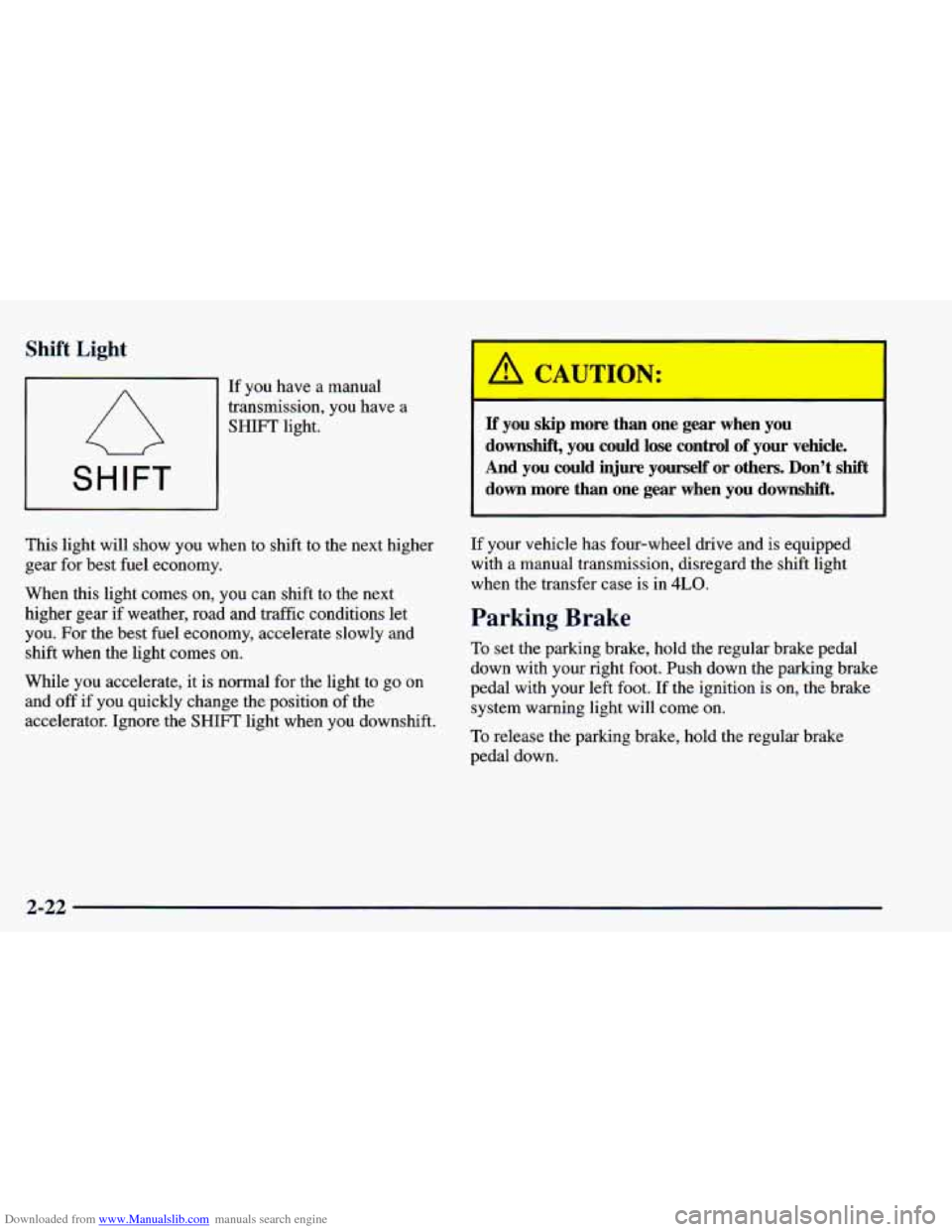
Downloaded from www.Manualslib.com manuals search engine Shift Light
A
SHIFT
If you have a manual
transmission, you have
a
SHIFT light.
This light will show you when to shift to the next higher
gear for best fuel economy.
When this light comes on, you can shift to the next
higher gear if weather, road and traffic conditions let
you.
For the best fuel economy, accelerate slowly and
shift when
e light comes on.
While you accelerate, it is normal for the light to go
on
and off if you quickly change the position of the
accelerator. Ignore the SHIFT light when you downshift.
I ' A CAUTION: I
If you skip more than one gear when you
downshift, you could lose control
of your vehicle.
And you could injure yourself or others. Don't shift down more than one gear when you downshift.
If your vehicle has four-wheel drive and is equipped
with a manual transmission, disregard the shift light
when the transfer case is in
4LO.
Parking Brake
To set the parking brake, hold the regular brake pedal
down with your right foot. Push down the parking brake
pedal with your left foot.
If the ignition is on, the brake
system warning light will come on.
To release the parking brake, hold the regular brake
pedal down.
2-22
Page 123 of 416
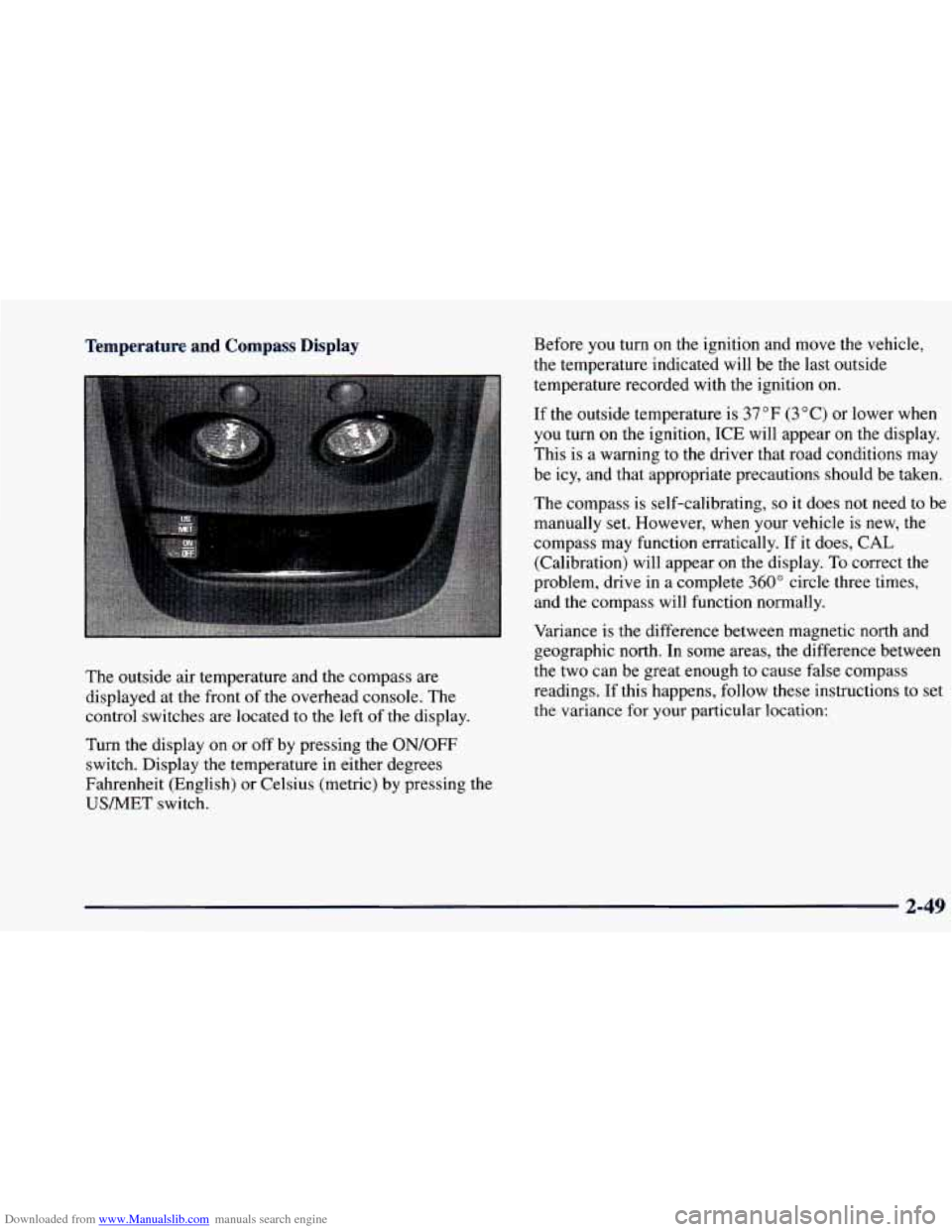
Downloaded from www.Manualslib.com manuals search engine Temperature and Compass Display
The outside air temperature and the compass are
displayed at the front of the overhead console. The
control switches are located to the left of the display.
Turn the display on or
off by pressing the ON/OFF
switch. Display the temperature in either degrees
Fahrenheit (English) or Celsius (metric) by pressing the
USMET switch. Before you turn
on the ignition
and move the vehicle,
the temperature indicated will be the last outside
temperature recorded with the ignition
on.
If the outside temperature is 37 OF (3 "C) or lower when
you
turn on the ignition, ICE will appear on the display.
This is a warning to the driver that road conditions may
be icy, and that appropriate precautions should be taken.
The compass is self-calibrating,
so it does not need to be
manually set. However, when your vehicle is new, the
compass may function erratically. If
it does, CAL
(Calibration) will appear on the display. To correct the
problem, drive in a complete
360" circle three times,
and the compass will function normally.
Variance is the difference between magnetic north and
geographic north. In some areas, the difference between
the two can be great enough to cause false compass
readings. If this happens, follow these instructions to set
the variance for your particular location:
2-49
Page 125 of 416
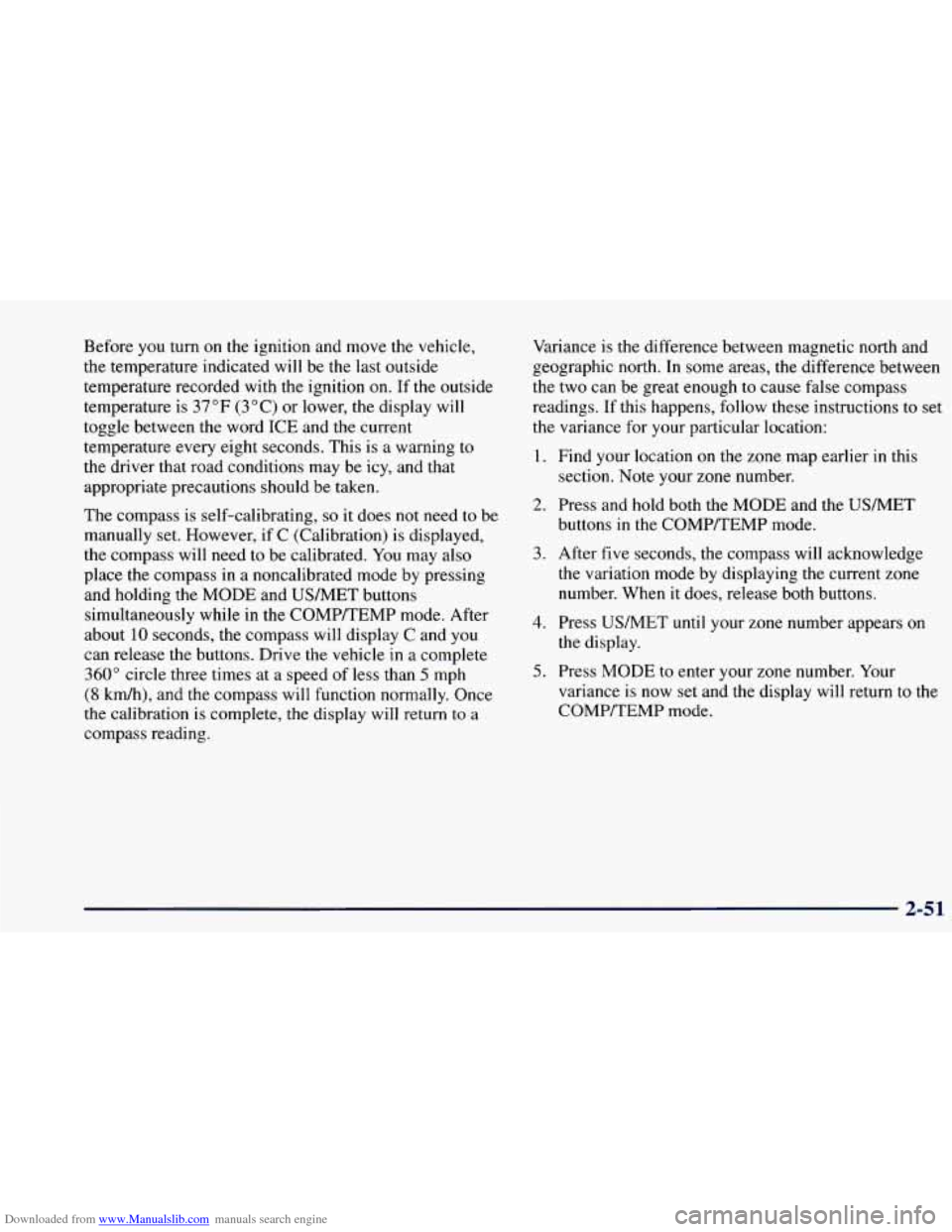
Downloaded from www.Manualslib.com manuals search engine Before you turn on the ignition and move the vehicle,
the temperature indicated
will be the last outside
temperature recorded
with the ignition on. If the outside
temperature is 37°F (3°C) or lower, the display
will
toggle between the word ICE and the current
temperature every eight seconds. This is a warning to
the driver that road conditions may be icy, and that
appropriate precautions should be taken.
The compass is self-calibrating7
so it does not need to be
manually set. However, if
C (Calibration) is displayed,
the compass will need to be calibrated. You may also
place the compass
in a noncalibrated mode by pressing
and holding the MODE and USMET buttons
simultaneously while in the COMPREMP mode. After
about
10 seconds, the compass will display C and you
can release the buttons. Drive the vehicle
in a complete
360" circle three times at a speed of less than 5 mph
(8 km/h), and the compass will function normally. Once
the calibration is complete, the display
will return to a
compass reading. Variance is
the difference between magnetic north and
geographic north. In some areas, the difference between
the two can be great enough to cause false compass
readings. If this happens, follow these instructions to set
the variance for your particular location:
1.
2.
3.
4.
5.
Find your location on the zone map earlier in this
section. Note your zone number.
Press and hold both the MODE and the
USMET
buttons in the COMP/TEMP mode.
After five seconds, the compass will acknowledge
the variation mode by displaying the current zone
number. When it does, release both buttons.
Press USMET until your zone number appears on
the display.
Press MODE to enter your zone number. Your
variance is now set and the display will
return to the
COMP/TEMP
mode.
2-5 1
Page 141 of 416
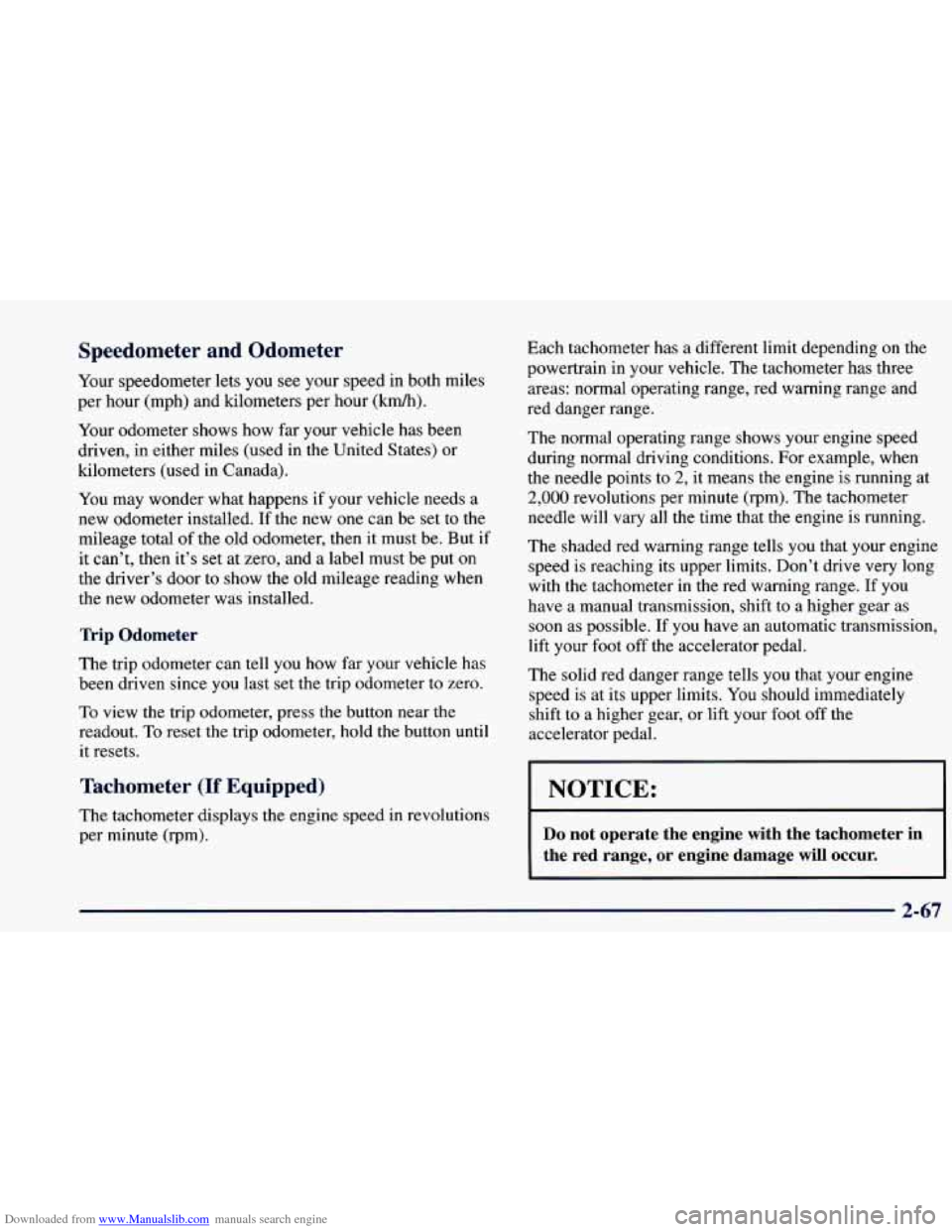
Downloaded from www.Manualslib.com manuals search engine Speedometer and Odometer
Your speedometer lets you see your speed in both miles
per hour (mph) and kilometers per hour
(kmh).
Your odometer shows how far your vehicle has been
driven, in either miles (used in the United States) or
kilometers (used in Canada).
You may wonder what happens if your vehicle needs a
new odometer installed. If the new one can be set to the
mileage total of the old odometer, then it must be. But
if
it can’t, then it’s set at zero, and a label must be put on
the driver’s door to show the old mileage reading when
the new odometer was installed.
Wip Odometer
The trip odometer can tell you how far your vehicle has
been driven since you last set the trip odometer to zero.
To view the trip odometer, press the button near the
readout. To reset the trip odometer, hold the button
until
it resets.
Tachometer (If Equipped)
The tachometer displays the engine speed in revolutions
per minute (rpm). Each tachometer
has a different limit depending on the
powertrain in your vehicle. The tachometer has three
areas: normal operating range, red warning range and
red danger range.
The normal operating range shows your engine speed
during normal driving conditions. For example, when
the needle points to 2, it means the engine
is running at
2,000 revolutions per minute (rpm). The tachometer
needle
will vary all the time that the engine is running.
The shaded red warning range tells you that your engine
speed is reaching its upper limits. Don’t drive very long
with the tachometer in the red warning range.
If you
have a manual transmission, shift to a higher gear as
soon as possible. If
you have an automatic transmission,
lift your foot
off the accelerator pedal.
The solid red danger range tells you that your engine
speed is at its upper limits. You should immediately
shift to a higher gear, or
lift your foot off the
accelerator pedal.
I NOTICE:
Do not operate the engine with the tachometer in
the red range, or engine damage will occur.
Page 142 of 416
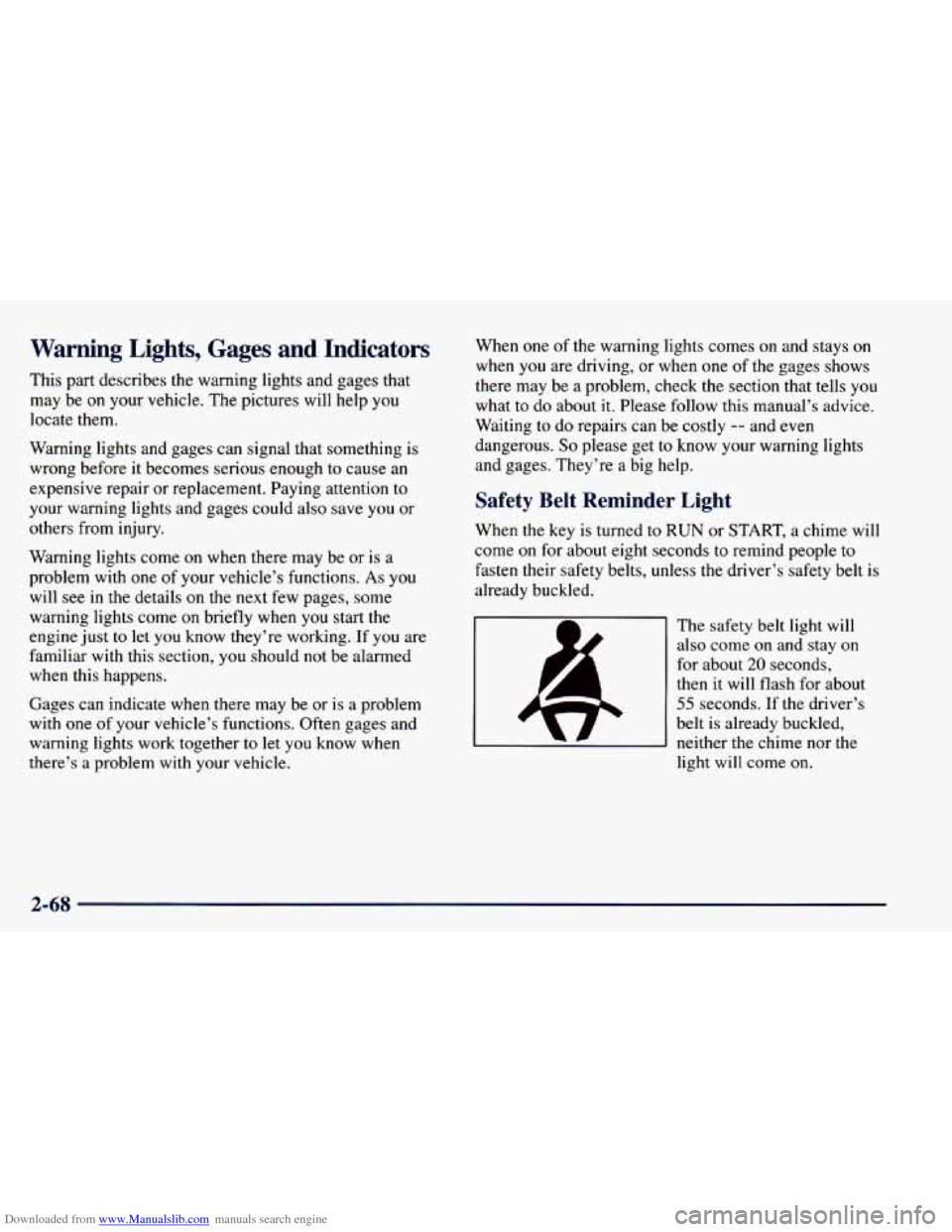
Downloaded from www.Manualslib.com manuals search engine Warning Lights, Gages and Indicators
This part describes the warning lights and gages that
may be
on your vehicle. The pictures will help you
locate them.
Warning lights and gages can signal that something is
wrong before it becomes serious enough to cause an
expensive repair or replacement. Paying attention to
your warning lights and gages
could also save you or
others from injury.
Warning lights come on when there may be or is a
problem with one
of your vehicle’s functions. As you
will see in the details on the next few pages, some
warning lights come on briefly when
you start the
engine just to let
you know they’re working. If you are
familiar with this section, you should not be alarmed
when this happens.
Gages can indicate when there may be or is a problem
with one of
your vehicle’s functions. Often gages and
warning lights work together to let
you know when
there’s a problem with your vehicle. When
one of the warning lights comes on and stays on
when you
are driving, or when one of the gages shows
there may be a problem, check the section that tells you
what to do about it. Please follow this manual’s advice.
Waiting
to do repairs can be costly -- and even
dangerous.
So please get to know your warning lights
and gages. They’re a big help.
Safety Belt Reminder Light
When the key is turned to RUN or START, a chime will
come
on for about eight seconds to remind people to
fasten their safety belts, unless the driver’s safety belt is
already buckled.
The safety belt light will
also come
on and stay on
for about
20 seconds,
then it will flash for about
55 seconds. If the driver’s
belt
is already buckled,
neither the chime nor the
light will come
on.
2-68
Page 144 of 416
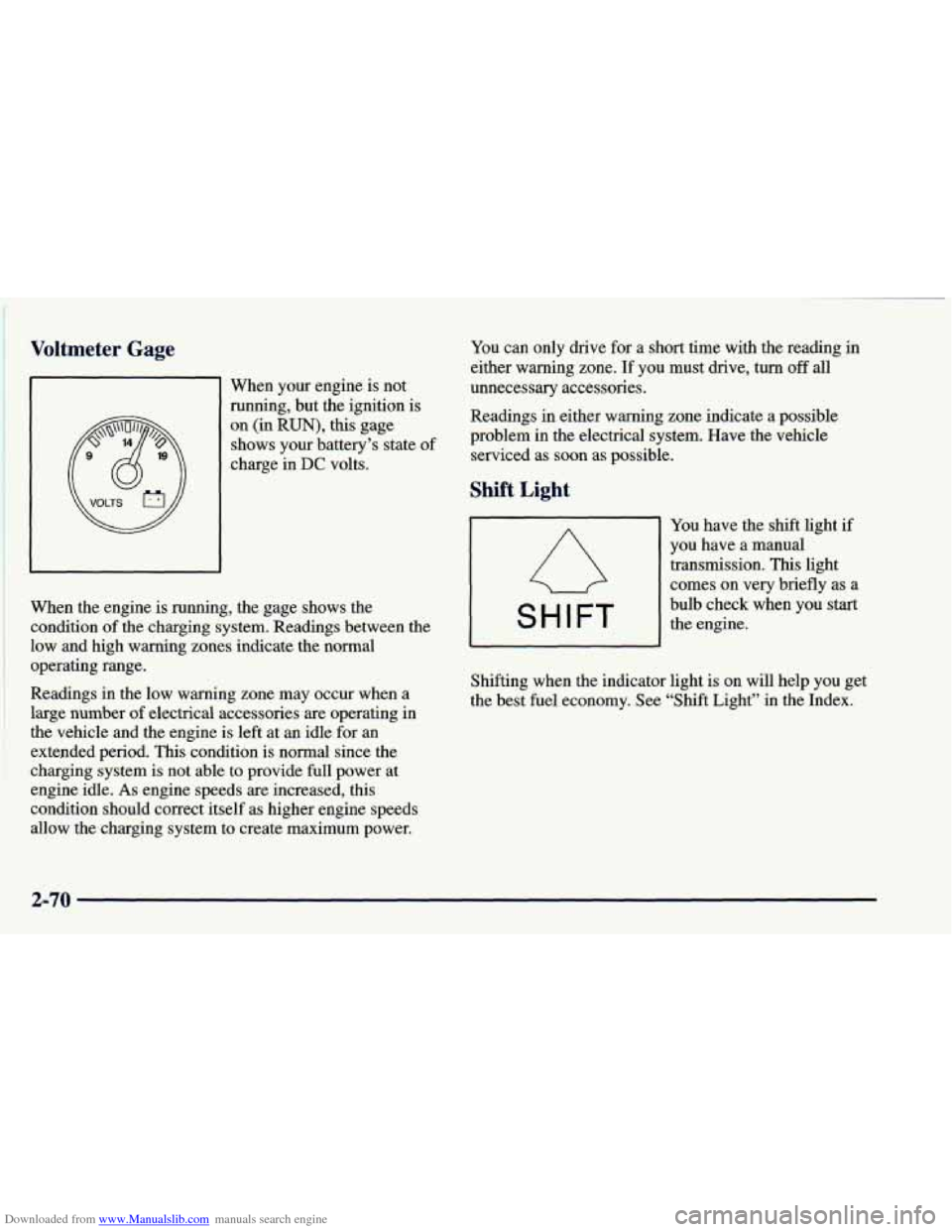
Downloaded from www.Manualslib.com manuals search engine Vo1’-- - - -* Gage
I When your engine is not
running, but the ignition is
on (in
RUN), this gage
shows your battery’s state of
charge in
DC volts.
When the engine
is running, the gage shows the
condition
of the charging system. Readings between the
low and high warning zones indicate the normal
operating range.
Readings in the low warning zone may occur when a
large number
of electrical accessories are operating in
the vehicle and the engine is left at an idle for
an
extended period. This condition is normal since the
charging system is not able to provide full power at
engine idle.
As engine speeds are increased, this
condition should correct itself as higher engine speeds
allow the charging system to create maximum power. You
can only drive for a short time with the reading in
either warning zone.
If you must drive, turn off all
unnecessary accessories.
Readings
in either warning zone indicate a possible
problem in the electrical system. Have the vehicle
serviced
as soon as possible.
Shift Light
You have the shift light if
you have a manual
transmission.
This light
comes on very briefly as a
SHIFT
bulb check when you start
the engine.
Shifting when the indicator light is on will help you get
the best fuel economy. See “Shift Light” in the Index.
2-70